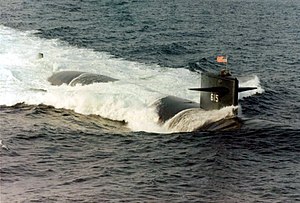USS Gato (SSN-615)
 USS Gato (SSN-615)
| |
| History | |
|---|---|
| Name | USS Gato |
| Namesake | The gato, a species of small catshark |
| Ordered | 9 July 1960 |
| Builder | General Dynamics Electric Boat |
| Laid down | 15 December 1961 |
| Launched | 14 May 1964 |
| Sponsored by | Mrs. Lawson P. Ramage |
| Commissioned | 25 January 1968 |
| Decommissioned | 25 April 1996 |
| Nickname(s) |
|
| Fate | Disposed of via Ship-Submarine Recycling Program |
| Badge |  |
| General characteristics | |
| Class and type | Thresher/Permit-class nuclear submarine |
| Displacement |
|
| Length | 292 ft (89 m) |
| Beam | 32 ft (9.8 m) |
| Draft | 28 ft (8.5 m) |
| Propulsion | S5W reactor with S3G-3 Core, two steam turbines with reduction-geared single shaft |
| Complement | 12 officers, 115 men |
| Armament |
|
USS Gato (SSN-615) was a Thresher/Permit-class nuclear submarine known as the "Goal Keeper" or the "Black Cat." She was the second United States Navy ship named after the gato, a species of small catshark found in waters along the west coast of Mexico.

The contract to build her was awarded to the Electric Boat Division of General Dynamics Corporation on 9 July 1960 and her keel was laid down on 15 December 1961 at Groton, Connecticut. She was launched 14 May 1964 sponsored by Mrs. Lawson P. Ramage, and was commissioned 25 January 1968.
On 15 November 1969, Gato collided with the Soviet submarine K-19 in the Barents Sea at a depth of some 200 feet (61 m). The impact completely destroyed the K-19's bow sonar systems and mangled the covers of its forward torpedo tubes. K-19 returned to port for repair but the Gato was relatively undamaged and continued her patrol.[1]
She was the first nuclear-powered submarine to completely circumnavigate South America, and the first nuclear-powered submarine to navigate the Strait of Magellan during its 1976 Unitas run under the command of Captain Partlow. It was on this voyage that it became the first nuclear submarine to travel through the Panama Canal.
Gato was decommissioned and stricken on 25 April 1996 and disposed of by submarine recycling.
References
- ^ Miller, David (2006). Submarine disasters. Guilford, Conn.: Lyons Press. p. 65. ISBN 978-1592288151. Retrieved 17 July 2015.
External links
